What's so nice about grids anyway? Some people collect rare coins and throw'em in a grid inventory; make-up boxes are filled with satisfying colored squares; your phone's home screen lets you neatly move your apps in any slot you so desire. There must be something deep in our subconscious that beckons us to seek the grid!
Welcome back to the second part of our fun little talk about inventories in games. If you missed part 1, Inventory Systems in Games - What's With All These Lists?!, I urge you to give it a read! For your convenience, however, I've recreated the part of the previous article that deals with the classification of inventory systems in the broad gaming medium, in the spoiler box below. Simply click it and it will expand! Otherwise, let's get right to it and talk about some grid-based inventories!
What informs the final design of an inventory system - that is, what players get their hands on - is the nature of the game it is a part in. There's a tight relationship between inventory and items, loot, mechanics such as power, and just itemization in general. Let's see some examples:
- An inventory may be seemingly infinite (such as Skyrim) or finite based on the available items in the game (such as Hearthstone's collections).
- An inventory's size may be constrained by other factors instead, such as weight (Skyrim), premium subscription (Elder Scrolls Online), bag size (World of Warcraft) or upgrades (Deus Ex: Human Revolution).
- An inventory system could be divided up into several sub-inventories (Hearthstone's several collections, Skyrim's tabs that sort by item type) or it could be a free-for-all (World of Warcraft's bags, save the recently-added Reagent Bag, can fit any item in the game in whatever order you wish).
- Speaking of order, inventories could be ordered by the game (Hearthstone cards ordered by Mana cost, Skyrim's sub-inventories alphabetically), or allow the player to order items (World of Warcraft).
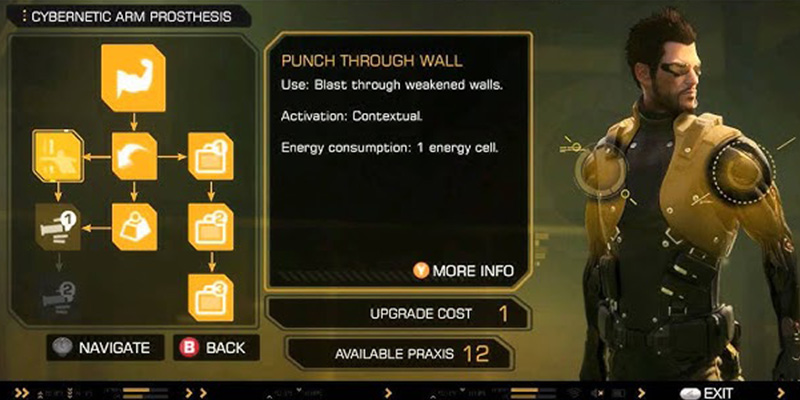
Deus Ex: Human Revolution's augmentation tree allows you to upgrade your inventory size three times.
At a base level, each inventory can allow or restrict player freedom depending on the context. There's nothing inherently wrong with the inventories I exemplified above, and certainly players' taste is varied enough for each iteration to have its fans. But what about informational distinctions?
- Inventories can be list-based, like in A Dark Room, or Skyrim (with a visual preview on the right, including stats, only when the item is selected).
- Inventories can be icon-based, like World of Warcraft, with a tooltip showing the item's stats only when the item is hovered over.
Additionally, we've also seen plenty examples of inventory layouts:
- The list, where reading item names is the main task players have while interacting with the inventory (Skyrim).
- The image list, where both the item's form as well as its stats are visible from the get-go (Hearthstone).
- The "visual horizontal list" (bear with me, I'm naming these on the fly!), used in games with small inventories, where all items are displayed, usually along with a keybind (Unreal Tournament).
- The grid, where seeing icons are what is used to inform the player of the nature of the item (World of Warcraft, DOTA).
- The, uhm, "Tetris grid", where each item takes up a specific amount of space and organizing your inventory is a mini-game (Diablo 2, Path of Exile, Deus Ex: Human Revolution).
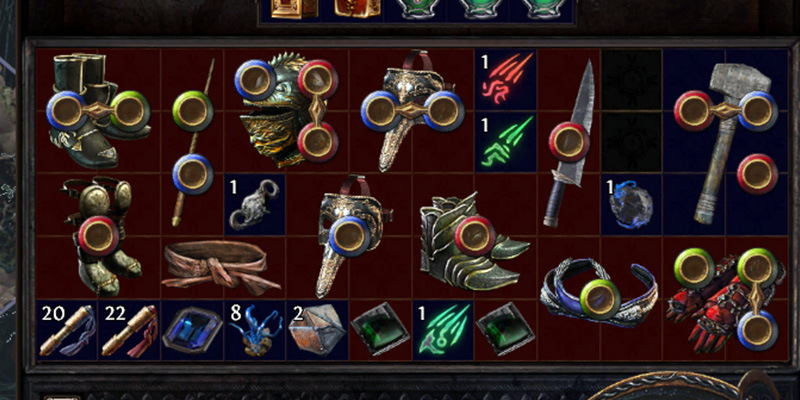
Path of Exile's inventory is uniquely vintage, but its wonkiness adds another layer of depth to loot management.
Lastly, player interaction:
- An inventory can be immutable when the player has no say in the ordering of items (Skyrim, Hearthstone, Unreal Tournament, A Dark Room, Elder Scrolls Online).
- An inventory can be mutable when the player can order items at will (World of Warcraft, DOTA, Diablo 2, Path of Exile, Deus Ex: Human Revolution).
This is to say, there's an overwhelming amount of ways to design an inventory system, and equal ways to make it great, or not so great. The examples I've listed above merely scratch the surface of a deep, dark chasm of inventory types. Talking about all kinds of inventories would be a novel-sized book, but let's discuss some of the pros and cons of the most popular inventory implementations.
Grids, Grids and More Grids - Going off the Grid with WoW, Minecraft, Path of Exile, Deus Ex: Human Revolution
I swear we're done with creative ways to use the word 'grid'. As we've previously discussed, grid inventories come in all kinds of flavors - finite, infinite, whole or divided into sub-inventories, and the differences continue. I've selected four games to help me discuss grid design: World of Warcraft & Minecraft, and Path of Exile & Deus Ex: Human Revolution. The first two are use a 'simple grid' (an item takes one slot), while the latter use a 'puzzle mini-game grid' (items take an arbitrary amount of slots depending on their 'real-life' size). Hopefully by comparing each pair we can gain some insight as to how their design best complements the game they're made for.
World of Warcraft

Everyone's heard of World of Warcraft. If you haven't played it, you must have come across footage of it at least once in your life! The most popular MMORPG on the planet has been using the same grid inventory system since 2004, and WoW is a great study for observing 'inventory creep' as well as what the developers did to attempt counteracting it.
World of Warcraft's inventory system is limited through bag size. To put things into perspective, the largest regular (not specific to a reagent type) bag you could have in 2004 had 20 slots. Today, the largest bag you can get (excluding the Horadric Haversack, which was only available during an event) has 34 slots. You can equip up to 4 regular bags next to your regular, permanent backpack (16 slots). Using the power of math:
- In Vanilla WoW, you could have up to 96 bag slots.
- In Dragonflight (latest expansion), you can have up to 154 bag slots, plus 4 if your Battle.net account has enabled two-factor authentication, plus 2 if you got your hands on the Horadric Haversack, and another 36 because DF added a fifth slot bag that accepts one Reagent bag. Maximum total: 196.
In the mid 2000s, you could say 96 slots was enough - after all, you also had the bank, where you could store seldom-used items instead of carrying them around. Today, it often feels like almost 200 slots is not enough. Moreover, the grid system's pros (knowing what an item is at a glance, easy sorting) are hanging on to dear life as the item bloat becomes too much. Here's my main character's bags, as well as the bank. In addition, my old main's bank is full and I've got another 6 Guild Vault bank tabs full of crafting materials to share between all my characters:
You see, a funny thing happens when you're 19 years and nine expansions into a game. Sure, the extra bag slots help, but there's just too much stuff you can't just let go of. I've got an entire bag dedicated to items I need for content from past expansions, because who knows when I feel like going there and putting them to use. I can't put them in the bank, because I've got so much crap stashed in there I'll just forget I even have those items and if I were to search for them I'm not sure I'd even find them!
World of Warcraft has, however, taken some steps throughout its long history to address both the lack of inventory space as well as the amount of items the game wants you to pick up:
- As previously stated, each expansion has increased the size of bags players can craft and equip.
- For a while, characters had a Keyring 'bag' to hold all their keys that opened doors, gates and stuff. That was removed midway through Cataclysm when many of those keys were made redundant, keeping things a little more clean in people's inventories.
- Also in Cataclysm, they added Void Storage, a sort of second bank with two tabs of 80 slots each where players could 'archive' certain gear pieces.
- In Warlords of Draenor, they added the Reagent Bank tab, with 98 more slots per character and meant to store crafting materials.
- Most importantly, in Wrath of the Lich King the Currency tab was added, moving several gold-adjacent (and even other stuff) systems within it. In fact, it's been used for so many currencies the community has, at several points, had to fight against Blizzard creating more currencies every single content patch.
- Bags were added the functionality of being able to auto-sort incoming (just looted) items depending on their type.
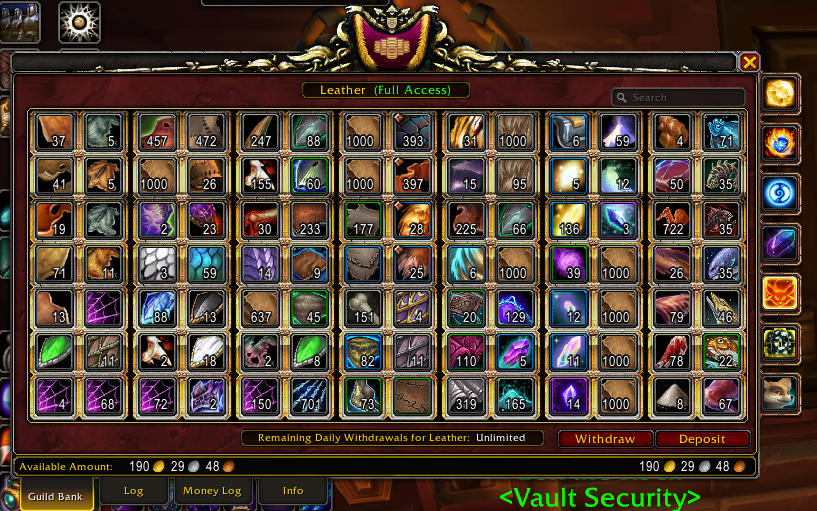
Yet I still need an entire tab just for leather.
On the other hand, these changes have always felt reactive rather than proactive - more of a band aid than a fix to the core issues the inventory system is facing:
- As the game continues to age and add content, item bloat increases. Tuning old content to be less of a time sink, for example, would probably clear half the items in the inventory image I posted above, since I'd actually be done with them in a respectable amount of time.
- Classes whose specializations include more than one role (DPS/healer/tank) have always been disadvantaged with having to carry 1-2 extra sets of gear. A "specialization gear" tab that would hold these sets of gear apart from the rest of the inventory would do wonders.
- The 36-slot reagent bag added this expansion would have been great in any other previous expansion, but Dragonflight added three different quality types for an overwhelming majority of its new reagents, meaning the bag is basically always full of DF crafting materials.
- Shadowlands saw the most absurd amount of items dropping everywhere. Open a chest? Here's 6 items, 3 of which are vendor trash. Kill a mob? Same story.
- To make matters worse, Shadowlands' main currency was Anima - a currency you first had to pick up, hold it in your bag, then transform it into currency at one of three specific places in the world. It gets worse: Itemized Anima came in over twenty flavors, and in some zones, you'd be holding about 8 different items that gave a different amount of Anima, if you'd take the pilgrimage to one of the transfer points. It is hard to understand how, in a game with already so many items, the developers thought it okay to fill a 32-slot bag within 5 minutes of gaming, half of these items being either utter trash or things you have to cumbersomely carry to a specific place to get rid of.
Yeah, WoW's inventory system is still functional, but everything around it is working against it. Initially, it was perfectly functional, but as the game aged, it was pushed over its limit.
Minecraft

Who doesn't love Minecraft? Grinches, of course. Minecraft's inventory system is quite similar to that of World of Warcraft, if you replace the word 'bank' with the word 'chest', and - in many modpacks - replace the word 'bag' with 'rucksack' or 'backpack'. The grid works the same - one item per slot, some items stack, and if you run out of space you can just craft more chests or craft more backpacks.
I won't be talking about vanilla Minecraft in this article. I'll be referring to the general experience of modded Minecraft, which almost always contains some mod that adds backpacks to the game, as well as an entire army of different chests with unique properties. Basically, most inventory problems in Minecraft can be solved if you just find the right mod.
Right off the bat, it's important to note a few things:
- Minecraft's basic inventory doesn't increase size. You've got your bag (27 slots) and your, well, to use a term from the previous article, "visual horizontal list" of items you can hold in your hand, just like Unreal Tournament's weapon bar.
- Minecraft, even with the biggest modpack you can find, still doesn't have as many distinct items as World of Warcraft. It does, however, have better ways of sorting your inventory.
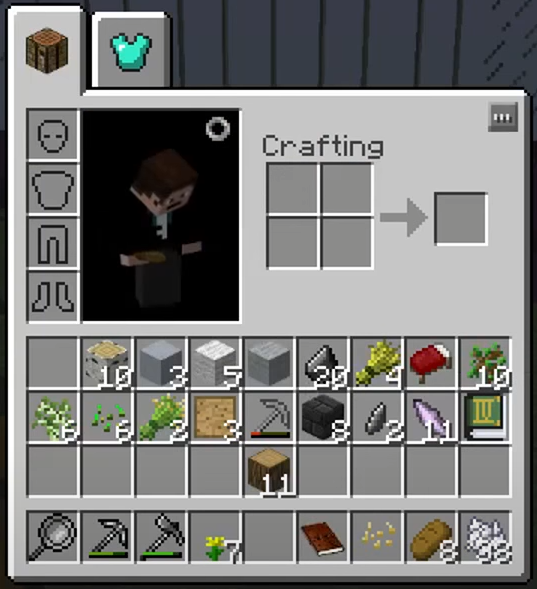
Let's imagine the following premise: You've got 200 different items in both Minecraft and World of Warcraft, and you've got to figure out a way to sort them in your various inventories. These are items of all types (gear, crafting reagents, Minecraft building blocks, WoW Anima etc.)
- For World of Warcraft, you don't want to fit your gear items into Void Storage because it costs 10g per item to deposit. Thus, you fill a whole big bag with them. Most of your crafting reagents fit into your Reagent Bank tab, but a few leftovers will sit in your Reagent bag. Your Anima, god help you, goes in about three different bank bags. All the other items, which don't have a clear 'type', are sorted throughout the rest of your bags and bank. Some of them share space with others of a different kind, but you do your best to keep things distinct. What you end up with is the images I showed above.
- For Minecraft, you keep whatever gear and tools you need on you. For every other item time (weapon/tools, armor, building block, ores, ingots, gems, eggs, dyes, wood, stones, food, buckets of liquid, monster bits & pieces) you just assign a chest for each one. For each chest, you put up a sign above it, and you just write in what's contained inside that chest. Done
In a world where every modpack adds another hundred+ items to the game, Minecraft's storage solution is simple: Make as many grid panels as you want, and label them. This is the solution to creating the perfect grid inventory in games with an absurd amount of items: Firstly, allow labeling the various containers. Secondly, allow players to divide the inventory in whatever way suits them. In World of Warcraft's case (limited slots per bag), allow further dividing bags into chunks in order to keep various item types separated.
Path of Exile

There it is: The classic Diablo inventory. One could argue this is one of the more realistic implementations of the way you have to place things inside a suitcase on the night before you go on vacation. The inventory puzzle mini-game of finding a way to make your items fit, just so you can pick up this promising pair of gloves off the floor, may seem archaic. Honestly, it probably is, but there's several reasons it is still an effective way to handle inventory:
- The added friction of having to spend time sorting our your inventory to make space for a few more items helps deter players from just picking up everything in loot-explosive games like Path of Exile.
- Each item having a different size (diff. number of slots occupied) is much more effective at helping players distinguish between different items. While all weapons in World of Warcraft are the same size in the inventory, you may have to hover over them and read their tooltip to know what type of weapon they are. In Path of Exile, it's pretty clear a wand isn't a two-handed axe.
- Items being "full size" in the inventory allows for other game mechanics to interact with the item, such as Path of Exile's socket system. In World of Warcraft, for example, socketing items is only possible because the game opens up an extra window.
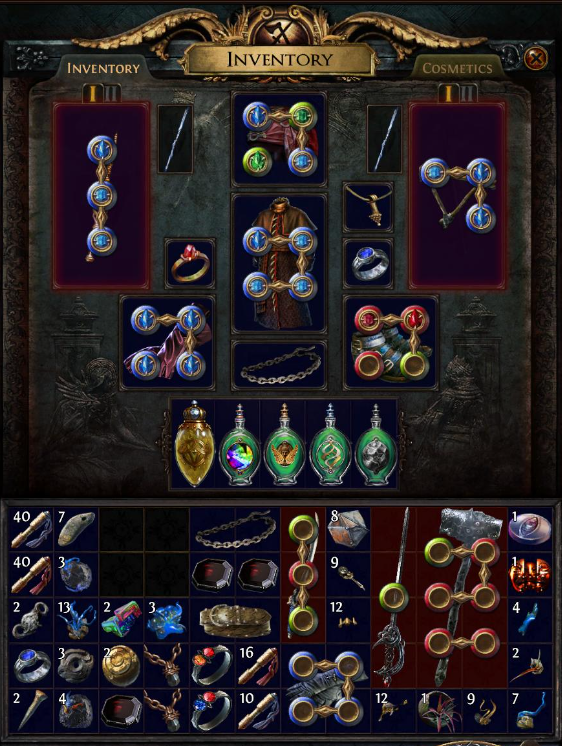
Naturally, Path of Exile's system is not perfect:
- There's a lot of loot picking in Path of Exile. Having to carry around stuff like Scrolls of Wisdom (to identify items) is not great when you're already dealing with a very limited inventory space. A system akin to WoW's 'currency' tab for super-basic stuff like Portal and Wisdom scrolls would go a long way. PoE already has a premium Currency tab, but it's restricted to the stash (you don't take it with you into maps).
- The system can become frustrating faster than the regular, one-item-per-slot grid, when you spend hours upon hours playing and every 10 minutes you need to stop and clean it up.
Make no mistake, Path of Exile, like its predecessors in this article, is bursting with items. What's more, the overwhelming majority of items a player interacts with have their stats randomly generated, which is not the case with most items in WoW and Minecraft. Why, when faced with an equally large amount of items, Path of Exile's inventory system holds up, is because of item scope.
The scope of items! WoW and Minecraft have you collecting a metric ton of crap with very specific uses. In Path of Exile, the entire item loot pool revolves around gear:
- Weapons, armor, jewelry, gems, flasks are the itemized half of any build. (GEAR)
- Currency takes up a single inventory slot and is used to directly modify gear.
- Fragments are used to open up special maps, which award gear.
- Divination cards can be exchanged for any of the above, including a lot of gear, so in the end, the only items you're really hanging on to in your actual inventory is gear.
- Gear has its own slots (duh!), because you equip it, so it takes no inventory space.
- You only really need some scrolls (if at all) at the bare minimum, before you go into a map.
- This is in contrast to World of Warcraft, where you need to carry around all sorts of trash on the off-chance you'd need to use it.
- This is in contrast to Minecraft, where you leave you home taking the entire tool shed with you (pickaxe, axe, sword, bow, arrows, torches, food, various cool modded items like grappling hooks etc.)
With such tightly designed item mechanics, where most non-gear items exist only to improve gear or grant access to better gear, Path of Exile's puzzle mini-game inventory fits like a glove.
Deus Ex: Human Revolution

Let's slow down a bit and consider Deus Ex: Human Revolution (HR), a lovely action RPG from 2011 that also implemented the puzzle mini-game grid inventory. First, it is important to distinguish Deus Ex from Path of Exile:
- While Path of Exile has an infinite amount of loot for you to cycle through, every item (bought or found) in Deus Ex: Human Revolution is limited. There are only so many cans of beer in the game, only so many pistols.
- While Path of Exile's inventory remains unchanged due to the nature of the game (you invest in your build, not your inventory), HR's inventory limitations are more closely tied to the rest of the game.
DE: HR can be played two ways: Lethally, or non-lethally (or a mix of both, you do you). As such, most items (equipment) available in the game can be divided the same way:
- Non-lethal weapons (tranquilizer rifle, concussion grenade etc.)
- Lethal weapons (sniper rifle, fragmentation grenade etc.)
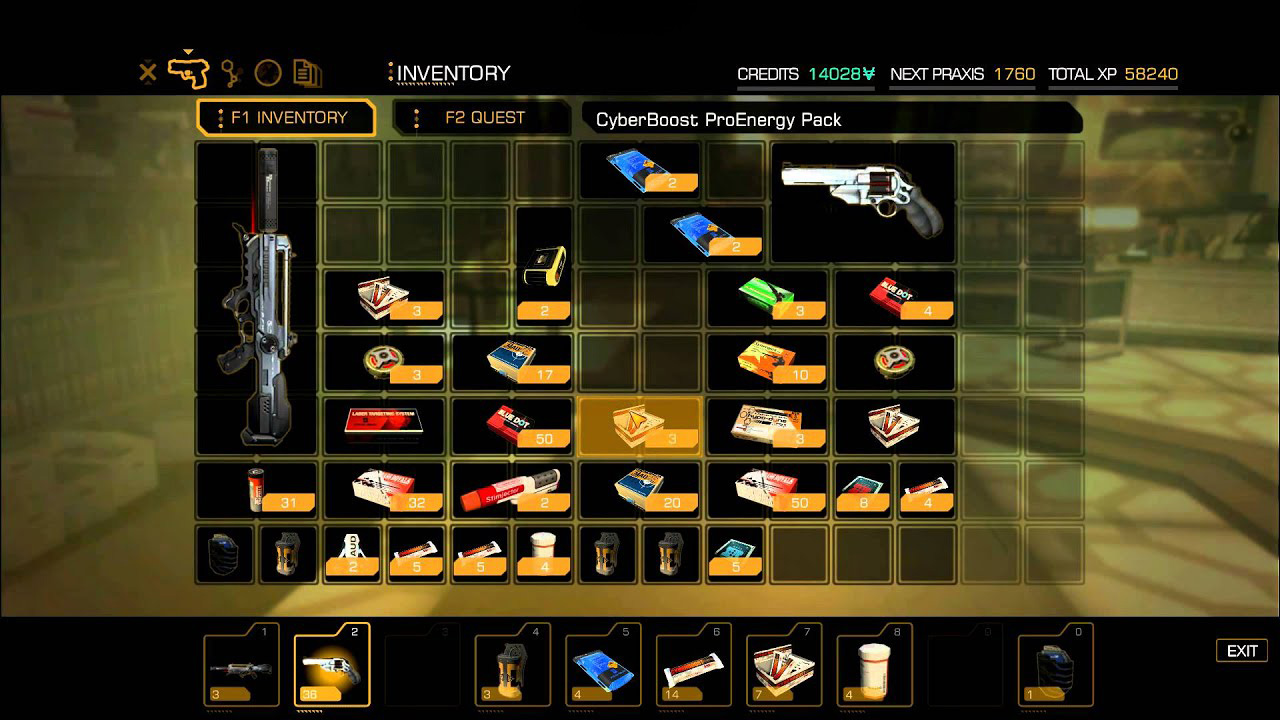
From the start, a player may choose to stick to one of these paths, and unknown to them, the way they interact with their inventory will change. HR's inventory can only fit so many weapons, bullets, software chips, beer, health kits and mines. Choosing, say, to play through the whole game non-lethally basically means you never need inventory space for all those pointless lethal weapons you come across. Choosing to be both lethal and non-lethal might make you want to invest in an inventory upgrade. Ding ding, keyword discovered:
- Deus Ex allows you to upgrade your maximum inventory capacity at the cost of 1 Praxis Point (you get 1 per level-up, find a few across the world, and buy a bunch).
- Its limited slots mean you'll have to make choices across your journey, deciding which items to hold on to, and which to leave on the ground.
- Depending on your playstyle, inventory management could be easy, or more difficult, and the game provides a way for you to remove some of that friction with inventory size upgrades.
Thankfully, quest items are held in a separate, immutable inventory space, the same as World of Warcraft has been doing since Mists of Pandaria. The opposite if true for Path of Exile, where quest items not only take precious inventory space, but are sometimes huge and can't be dropped! Also interesting to note, Human Revolution has its own "visual horizontal list" like Minecraft, but you won't get away with slotting a weapon in one of those slots and clearing it from your inventory - items just have more weight in this game.
Yesterday, we went through the list inventories and today we conquered the grids. I hope by now you have a general idea of how these inventories are most commonly implemented, their pros, their cons and their quirks. Join me for the last part of this inventory system rant where we'll have some fun and take a look at some absolutely bizarre storage solutions across gaming.
With all this newfound perspective on inventories, tell me: What's one game that could have benefitted from a completely different inventory design? Let me know in the comments below!
Read the previous entry as well as the final part of this series:
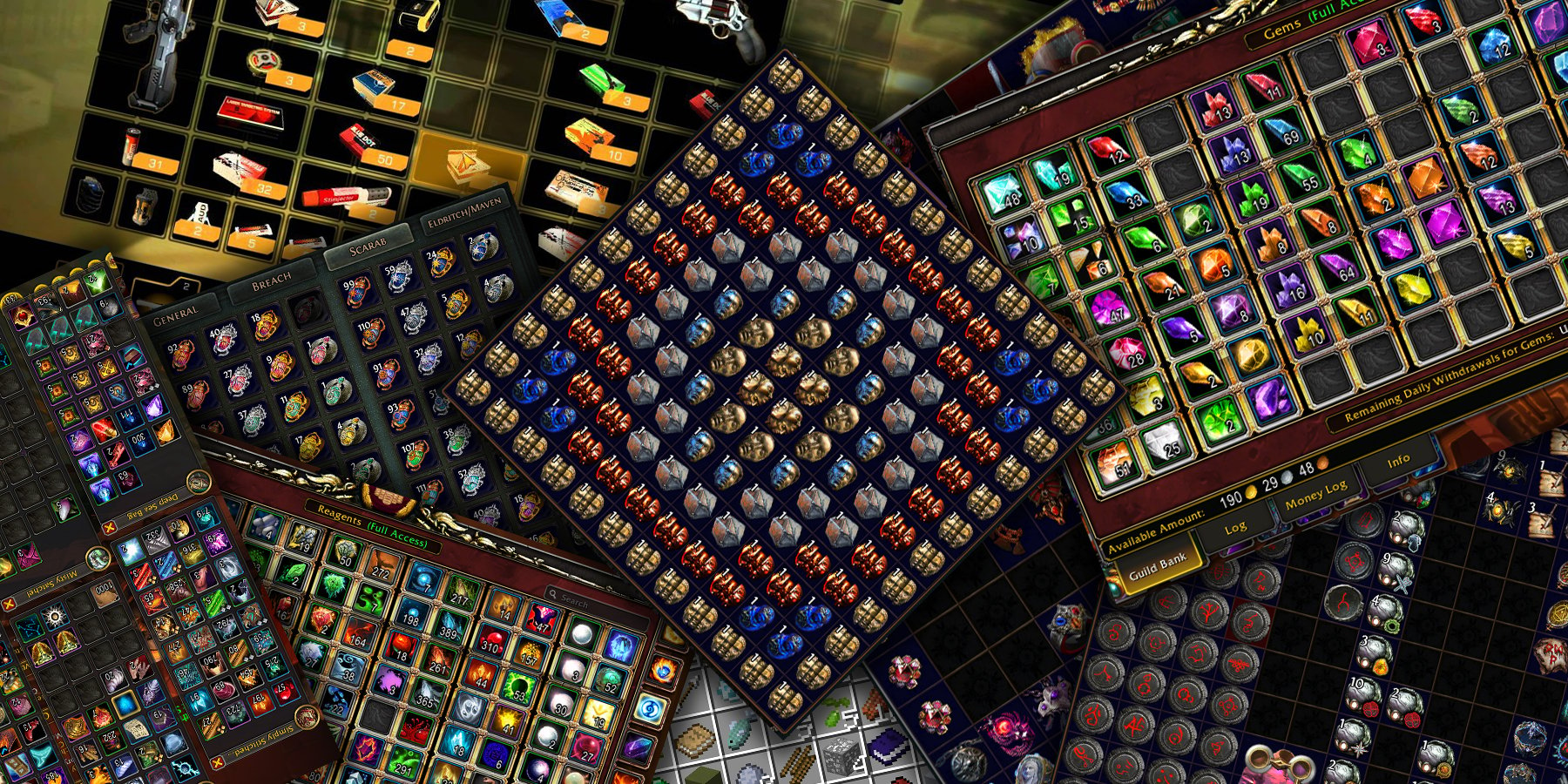
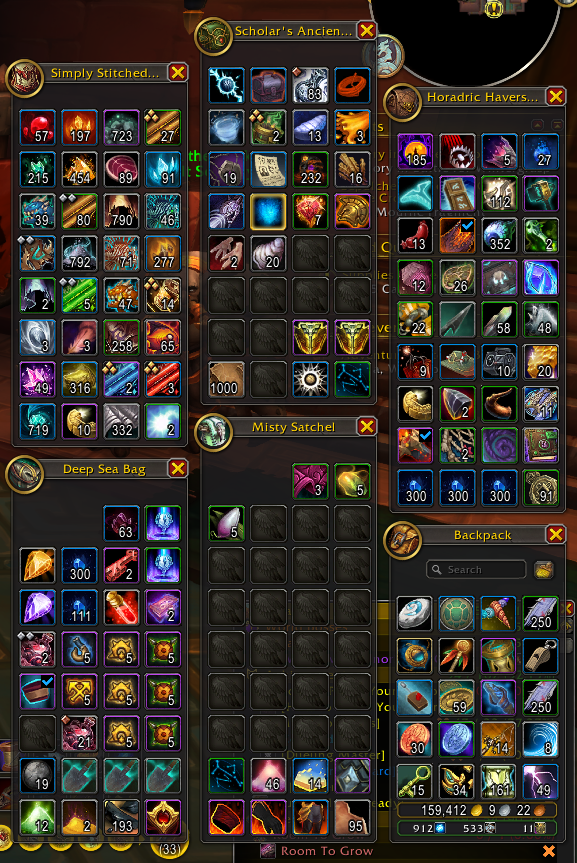
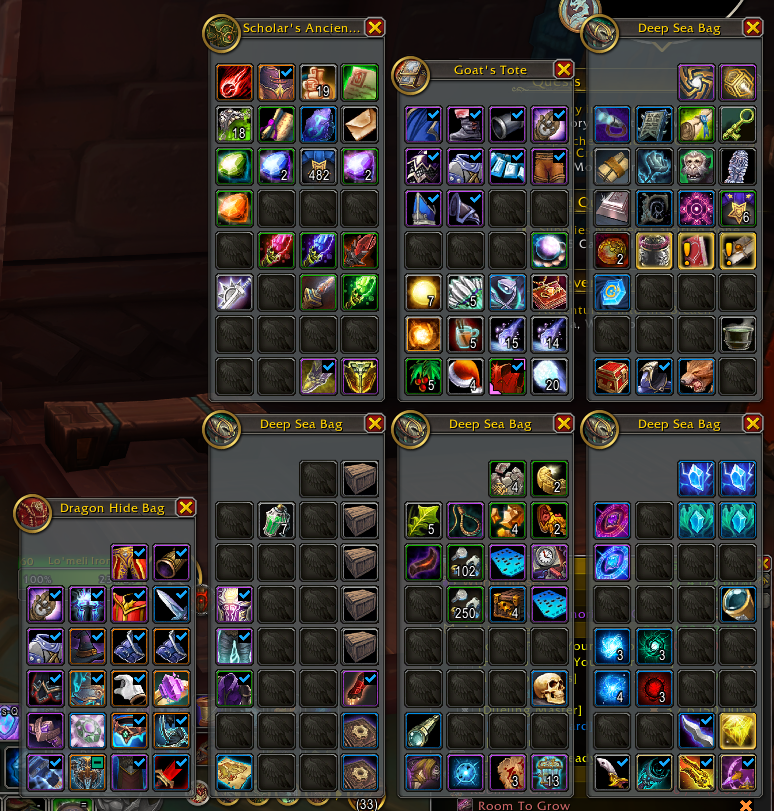
Comments
There's only one issue with these inventories: stack sizes.
If WoW increased it to like 5000 per slot, you wouldn't have issues in freeing up slots.
Secondly, it's the hoarding mentality of people, not willing to disband whatever crap items they will probably never use. Or their inability to categorize items in bags/bank so they can be easily found.
I know, it's not impossible, it just takes a lot of time. But the sense of "order" that one feels at the end is priceless.
I've found the new stack size for WoW reagents (of 1000x) to be pretty good, apart from the enormous quantities of Desolate Leather I seem to be hoarding in the guild tab screenshot above. It's more all the little situational stuff that bogs me down: shadowlands reagents for that secret Maw mount, items related to that whole "demon eye grind" thing in Argus, six different rare materials required for upgrading Dragon Isles fishing etc.
There's just a lot of stuff that the game has you carry around unless you no-life the content tied to it for hours at an end (horrible). Throw it in your bank? You just might forget it exists.